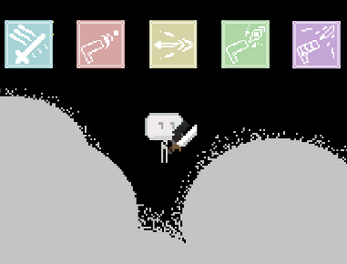Game Mechanics - Project 5 - Ability
NOTE: TO SEE THE WHOLE GAME AND TO FIX THE TEXT AT THE BEGINNING, SET THE GAME TO FULL SCREEN
This is the fifth project by Team Blue for Northeastern's Game Mechanics (GAME4000) class. While improving on visual scripting skills, Unity Game Engine, and collaboration, our goal was to design a progressive mechanic for a game.
CONTROLS:
1 - Slash
2 - Shoot
3 - Spear
4 - Pierce Shot
5 - Sword Gun
OBJECTIVE:
Destroy the ghosts and don't let them reach you!
GENERAL DESIGN NOTES:
Progression Mechanic Name: Melee Attacks & Shooting Description of mechanic and its progression: Melee attacks are short-ranged attacks that a player can use to inflict damage on opponents. Our player starts off with a sword that can only be used in a close range environment. However, as they progress their weapon - they unlock a gun. This gun allows for a slower rate of fire, but a longer range. The player is allowed to use both. The player then unlocks a spear. The spear is used as a long-range version of the sword. The player then gains access to a piercing bullet gun. This gun is an upgrade of the previous one in that it can now go through multiple enemies. Upon completion of the progression system, the player unlocks the Sword Gun. A gun that shoots swords and does more damage and has a really big range. Each upgrade allows the player to do more damage or to have a larger attack range. Description of how your pattern(s) relate to the prototype. (Include a link the to pattern) https://patternlanguageforgamedesign.com/PatternLibraryApp/PatternLibrary/2023 The pattern relates to our prototype because of our enemy wave system. As our player defeats enemies, upgrades become available in the middle of an enemy wave. This gives players an upgraded weapon in terms of damage or range while fighting a static difficulty level of enemies. However, as players move onto different waves, the enemies get harder and gain more health points. This clearly shows the non-linear & non-parallel relation between world-difficulty and player progression. While players may gain new upgrades mid-wave, those upgrades slowly become less useful as the enemies become harder. This requires the player to struggle for a bit with their new upgrades until they unlock the next upgraded weapon. Analysis describing the implications of the progression explored in your playable prototype. There are many different implications with our progression system. To start - there needs to be a discussion on the actual mechanics of attacking. We experiment with range, cool-down time, and damage. All three of these can change the usefulness of the weapon and the empowerment that the weapon can give a player. In the case of our game - damage is clearly the most important upgrade to get as the enemies have extremely low health points (1-5). Enemies can die in either 5, 3, 2, or 1 hits, depending on the damage that the weapon has. Similarly, it seems that range becomes less important over time as the player will have to deal with more enemies that have larger health pools. Thus, weapons with a shorter cool-down period become more useful as they can eliminate enemies quicker in an enemy wave game. Another implication that is important to discuss is the “experience points” design of our progression system. Players gain access to new upgrades after they kill a certain amount of enemies. This gives a tangible way for players to gauge a time for how much longer they need to kill things until they get an upgrade. Having too few enemies to kill to upgrade doesn’t allow players to experience the strengths and weaknesses of weapons. This can also impact the feeling of empowerment that players may get through upgraded skills as it would be extremely easy to get new upgrades. Having too many enemies to kill to upgrade to the next weapon can make the player get bored of using the same weapon for too long. It can also make the difficulty of the game extremely stagnant unless you really push the limits of your weapon. A final thing to consider regarding our progression is the amount of upgrades available for a player. Having too many upgrades can make the player feel a lack of satisfaction as there is no end goal for them to reach. As our game doesn’t have a point-system such as Tetris or Call Of Duty (not really points, but an increasing counter for # of waves you’ve survived), it would be extremely unwise for us to not have implemented a final upgrade for players to reach. Having too many upgrades can also make the game feel extremely drawn out and tedious as it would take a very long time to reach the end. Having too little upgrades can make players feel bored due to a lack of new ways to master the game. It also subsequently makes the game shorter in our case.

Leave a comment
Log in with itch.io to leave a comment.